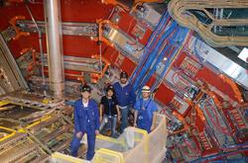Outer Hadron Calorimeter
Silicon Photomultipliers for the HCAL Upgrade
Compact Muon Solenoid Experiment
Silicon Photomultipliers for the HCAL Upgrade
The CMS Outer Hadron Calorimeter (HO) lies outside the solenoid magnet, hence provide additional calorimeter coverage to improve the missing energy resolutions and also are sensitive to the muons.
SiPM are a relatively young class of photosensors that allow for new approaches in the design of scintillator calorimeters. CMS, as an established experiment, has been looking into the use of these sensors to refine the performance of their calorimetric system. HO is the first large scale hadron collider detector to use Silicon Photomultipliers (SiPMs). The R&D of the project took place around 2011 followed by production, testing and the final state installation. The timely dedicated efforts of DESY group lead to complete installation of SiPMs by first week of April, 2014.
With the excellent performance of the SiPMs and the fact that HO forming the bottom most layer for the muon detector, efforts are ongoing for implementing the HO information to the L1 muon trigger to improve the trigger performance in Run-2 of Large Hadron Calorimeter (LHC). DESY is also leading the efforts for this project.
At present, the detector links are being commissioned and the integration into the L1 trigger is under study.
Also, we plan to upgrade the back-end electronics of HO with the improved latest technology based on uTCA (micro Telecommunication Computing Architecture). We foresee much improved performance in L1 muon trigger after switching to this new technology, as we will gain flexibility in sending
more information to the muon trigger system.
There are good opportunities for new students to contribute in this project, to perform the physics studies, also to contribute in firmware writing and other aspects of this project.
